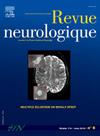Data linkage between the French multiple sclerosis cohort (OFSEP) and the French national health insurance database (SNDS)
IF 2.3
4区 医学
Q2 CLINICAL NEUROLOGY
引用次数: 0
Abstract
Background
Linking disease registries to nationwide healthcare administrative databases increases the research opportunities. Recent guidelines emphasize the need of transparency in this process.
Objective
Our aims were to describe the process of record linkage between the French multiple sclerosis (MS) cohort (OFSEP) and the national health insurance database (SNDS) and to evaluate the linkage quality.
Methods
As no unique identifier was available in the two databases, the OFSEP-SNDS data linkage was performed by indirect matching using the following sixteen patient variables to create a unique key: sex, dates of birth and death, of visits to a neurologist, of MS-related hospitalizations, of MRI, and use of disease-modifying therapies. Three indicators were computed to assess the linkage quality.
Results
Among the 52,034 eligible patients in the OFSEP registry, 42,603 (81.9%) were matched with patients in the SNDS database, with good overall quality (robustness = 3.19; this is the number of linkage variables that can be removed without losing the uniqueness of the linked pair; 87.8% of common information). Comparison of the linked and unlinked populations revealed no major selection bias regarding age and sex distributions.
Conclusion
The successful linkage of more than 40,000 patients with MS broadens the research perspectives by allowing access to a wide range of clinical and administrative data (e.g., comorbidities, care pathways) over a long mean disease duration (> 15 years).
法国多发性硬化症队列(OFSEP)和法国国家健康保险数据库(SNDS)之间的数据链接。
背景:将疾病登记与全国卫生保健管理数据库联系起来增加了研究机会。最近的指导方针强调这一进程必须具有透明度。目的:我们的目的是描述法国多发性硬化症(MS)队列(OFSEP)与国家健康保险数据库(SNDS)之间的记录链接过程,并评价链接质量。方法:由于两个数据库中没有唯一标识符,OFSEP-SNDS数据链接通过使用以下16个患者变量间接匹配来创建唯一关键:性别、出生和死亡日期、神经科医生就诊次数、ms相关住院次数、MRI和使用疾病改善疗法。计算了三个指标来评估联动质量。结果:在OFSEP登记的52,034例符合条件的患者中,42,603例(81.9%)与SNDS数据库中的患者匹配,总体质量良好(鲁棒性=3.19;这是可以在不失去链接对唯一性的情况下移除的链接变量的数量;常用信息占87.8%)。对关联人群和非关联人群的比较显示,在年龄和性别分布方面没有重大的选择偏差。结论:超过40,000名MS患者的成功关联拓宽了研究视角,允许获得广泛的临床和管理数据(例如,合并症,护理途径),平均疾病持续时间较长(约15年)。
本文章由计算机程序翻译,如有差异,请以英文原文为准。
求助全文
约1分钟内获得全文
求助全文
来源期刊

Revue neurologique
医学-临床神经学
CiteScore
4.80
自引率
0.00%
发文量
598
审稿时长
55 days
期刊介绍:
The first issue of the Revue Neurologique, featuring an original article by Jean-Martin Charcot, was published on February 28th, 1893. Six years later, the French Society of Neurology (SFN) adopted this journal as its official publication in the year of its foundation, 1899.
The Revue Neurologique was published throughout the 20th century without interruption and is indexed in all international databases (including Current Contents, Pubmed, Scopus). Ten annual issues provide original peer-reviewed clinical and research articles, and review articles giving up-to-date insights in all areas of neurology. The Revue Neurologique also publishes guidelines and recommendations.
The Revue Neurologique publishes original articles, brief reports, general reviews, editorials, and letters to the editor as well as correspondence concerning articles previously published in the journal in the correspondence column.
 求助内容:
求助内容: 应助结果提醒方式:
应助结果提醒方式:


